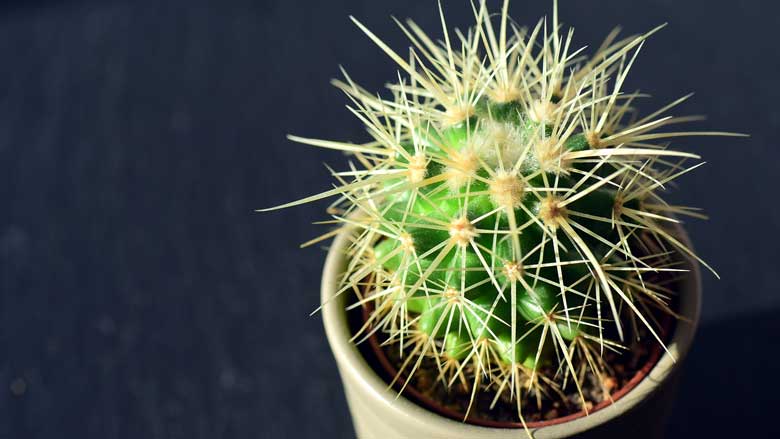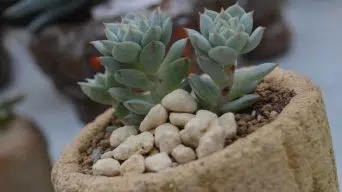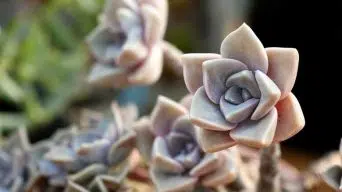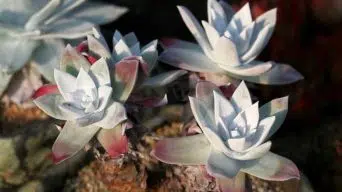To repot a cactus, wear gloves, gently slide it from the old pot, add well-draining cactus soil to the new pot, place the cactus, and let it settle for a week before watering. Repot every 3-4 years or when roots show.
Do you have a cactus that’s starting to look a little too big for its pot? Or maybe the soil is starting to dry out, and your cactus is looking a bit sad.
It’s time to repot your cactus!
Repotting a cactus is an easy process that can be done in just a few simple steps.
In this article, we will walk you through the process of how to repot a cactus safely and effectively.
How To Know When to Repot a Cactus?
Most cacti will only need repotting every two to five years.
However, there are a few signs to look for that indicate it may be time to transplant your cactus into a larger pot.
If you observe any of the following, it’s time to repot your cactus:
1. The Pot Is Too Small
When a cactus plant is root-bound, the roots have nowhere to grow and begin to crowd the bottom of the pot.
If you see roots coming out of the drainage holes or winding their way around the outside of the pot, it’s time for a larger pot.
2. The Soil Is Drying Out Quickly
When a cactus is pot-bound, the soil will become dry very quickly. This is because the roots take up all the moisture in the pot.
If you find yourself watering your cactus more than once a week, it’s probably time to repot.
3. The Plant Is Tilting or Leaning
A healthy cactus should be standing tall and proud in its pot.
If your cactus is leaning to one side or the other, it indicates that the pot is too small and the roots are crowded.
4. The Plant Is Outgrowing Its Pot
As your cactus grows, it will eventually become too large for its pot.
You’ll need to repot your cactus into a larger pot when this happens.
You can also divide your cactus into multiple smaller plants and pot each one separately.
5. The Pot Is Starting to Crack or Break.
If your pot starts to crack or break, it’s time for a new one.
The same goes for pots that are chipped or have any other kind of damage.
6. The Cactus Is Top-heavy and Might Fall Over
A cactus that is top-heavy is at risk of falling over.
If your cactus has a large, heavy top and a small, lightweight bottom, it’s time to repot into a heavier pot.
7. The Cactus Is Wilting or Looking Overall Unhealthy
If your cactus is wilting, has yellow or brown leaves, or is otherwise looking unhealthy, it might be a sign that it’s not getting enough light, water, or nutrients.
Before you repot your cactus, make sure to check its lighting, watering, and fertilizing requirements.
But if you’re unsure of what’s causing the problem, repotting your cactus into fresh soil might be just what it needs to get back to good health.
When Is the Best Time to Repot Your Cactus?
The best time to repot a cactus is during the growing season, typically in the spring or summer.
This is because the plant will be actively growing and will be able to recover from the repotting process more quickly.
However, you can repot cacti at any time of year as long as it’s not during its dormant period.
During the dormant period, the cactus is not growing and will not be able to recover from the repotting process.
How Often Should You Repot Cactus Plants?
Growing cactus plants can be a fun and rewarding hobby.
But like all plants, they need the right care to stay healthy.
One important part of caring for a cacti is knowing when and how to repot it.
So, how often should you repot cacti? Generally, you should repot your cactus every two to three years.
However, you may need to do it more or less frequently, depending on your size and type of cacti.
Repotting succulents and cacti is a great way to give them a fresh start and encourage new growth.
If your plant looks etiolated (leggy), has stopped growing, or is starting to look cramped in its pot, it’s probably time for a repot.
On the other hand, if your cactus is small and isn’t showing any of these signs, you can probably wait a few more years before repotting.
In general, it’s better to err on the side of repotting too often rather than not enough. Your plant will always have fresh soil and room to grow.
How to Repot a Cactus Plant Step-by-Step
It’s easy to forget about your cactus plant until it looks wilted.
Don’t be discouraged when your beloved plant needs a new pot!
Repotting cacti is easy and only takes a few simple steps.
Follow these easy steps to repot your cactus successfully:
1. Gather Supplies
Before you start, ensure you have all the tools you need.
You’ll need a new pot (one size larger than the current pot), a potting soil mix, a small shovel, and a knife or scissors.
As cactus spines can be pretty sharp, it’s also a good idea to have gardening gloves, newspaper, or a towel to protect your hands and surfaces.
2. Prepare the New Pot
If you’re using a new pot, start by giving it a good wash with soap and water.
Ensure the new pot has drainage holes in the bottom so your plant doesn’t become waterlogged.
Rinse it well, and then let it dry completely. Once the pot is dry, add an inch or two of the potting soil mix to the bottom.
Cacti need a soil that drains well, so don’t use regular potting soil or garden soil.
The best potting mix type is a succulent and cactus mix, or you can make your own by mixing one part potting soil, one part coarse sand, and one part perlite.
3. Remove the Cactus from the Current Pot
Carefully remove the cactus from its current pot. Remove any old soil that’s clinging to the roots, and then use a small shovel to help loosen any large clumps of soil.
If the potting mix is really stuck to the roots, you can use a knife or scissors to cut it away.
Using a knife or scissors, carefully cut away the potting mix from the root ball to ensure that all of the roots are exposed and free from any soil or debris.
Be careful not to damage the cactus’ roots in the process.
If the plant is rootbound (meaning the roots are growing in a tight circle), gently loosen them with your fingers before removing the plant.
Once the plant is out of the pot, check for any damaged or rotting roots and trim them away with a sharp knife or scissors.
The remaining roots should be white or light-colored.
The plant will be more susceptible to root rot if the damaged roots are not removed.
4. Put the Cactus in the New Pot
Once you’ve trimmed the roots, carefully place the cactus in the new pot.
Make sure it’s positioned at the same depth as it was in the old pot, and that the plant is centered within the new pot.
Incorrect positioning could cause the plant to lean or topple as it grows.
Gently fill the gaps around the roots with more potting mix, lightly packing it in place using your fingers.
Avoid packing it too tightly, as excessive pressure can harm the delicate roots.
Cacti require minimal watering, so only add enough potting mix to cover the roots.
You can add gravel to the potting mix to aid drainage, allowing excess water to escape from the roots and preventing the cactus from becoming waterlogged, which could damage its delicate roots.
Avoid using Sphagnum moss, as it tends to retain excessive moisture, which is detrimental to cacti
5. Place the New Pot in a Bright Location
After you’ve repotted the cactus, find a sunny location for it to live in.
Cacti need at least six hours of sunlight each day, so a south- or west-facing window is ideal.
However, if you live in a hot climate, your cactus may prefer some shade during the hottest parts of the day.
6. Don’t Water the Cactus After Repotting
Once you’ve repotted your cactus, resist the urge to water it right away.
It’s best to wait a week before watering so the roots can adjust to their new home and start growing.
After a week, start watering your cactus only when the soil is dry to the touch.
Cacti are susceptible to root rot, so it’s important not to overwater them.
Water your cactus less in the winter months as they typically go dormant during this time and don’t need as much water.
How to Care For Newly Repotted Cactus
After repotting cactus plants, it’s essential to understand how to care for them in the weeks and months following.
As cacti adjust to their new container and grow, they will be more susceptible to root rot and other problems.
Here are a few tips for caring for newly repotted cacti:
- Do not water for at least one week after repotting it.
- Once you do start watering it again, be very careful not to overdo it; provide only a small amount of water at a time and wait until the soil is dry before watering again.
- Make sure the pot has good drainage so that cacti can’t sit in water and rot its roots.
- Place cacti in a sunny spot where it gets at least six hours of direct sunlight per day.
- Keep an eye for any signs of problems (e.g., wilting, shriveling, discoloration) and address them as soon as possible.
By following these tips, you can help cacti make a smooth transition to its new pot and thrive for many years to come.
Final Thoughts
Houseplants, such as cacti, are a great way to add a unique touch to your home.
With proper care and attention, they can provide a beautiful and vibrant addition to any living space for many years to come, making them an ideal choice for those looking to add some greenery to their home without the hassle of keeping up with more demanding houseplants.
One of the most important things you can do for your cactus is to repot it every one to two years or whenever it becomes rootbound.
Repotting a cactus is not difficult, but it’s important to do it carefully to avoid damaging the plant.
By following the steps outlined in this article, you can repot your cactus with ease and help it thrive for years to come.







